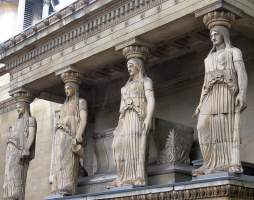 Caryatids at Euston, by J. C. F. Rossi.
Caryatids at Euston, by J. C. F. Rossi.
 Caryatids at Euston, by J. C. F. Rossi.
Caryatids at Euston, by J. C. F. Rossi.
A Caryatid is a female figure used as an architectural support in place of a pillar. The male equivalent is an Atlantes, and these too are covered on this page – though the female is much the more common. This page gives mostly Victorian examples, grouping them into the two classes of full and half figures, and aiming to give a representative sample of poses and styles. The vertical nature of the photos means you will need to click on the thumbnails to enlarge them to see them properly, rather than lazily read the text and squint at the miniature versions.
The archetypical Caryatids, of course, are those on the Erechtheum in Athens, and the one that escaped and can be seen in the British Museum. They inspired a set of terra cotta Caryatids by J. C. F. Rossi on the church of St Pancras almost directly opposite Euston Station on Marylebone Rd, London, shown above. In these figures, then, we can see a Caryatid replacing a pillar; her foot is on the base, her body forms the shaft of the pillar, and the capital of the pillar rests on her head. Along Marylebone Rd from St Pancras we have the prominent spire of Marylebone Parish Church, with gilded angels acting as Caryatids on the tall spire, each with one arm raised to add to the support - illustrated below. We can note that there is no appearance of effort or strain in the Caryatid as she supports the great weight, and this is usual.
Here are two superb, exotic Atlantes, or male figures as pillars, here as great Djinns, turbaned and mighty, who form either side of the doorway to Drapers Hall, Throgmorton Street in the City. Full capitals rest on their heads. These are among the finest of the Atlantes I know, sculpted by H. A. Pegram. They are attached to the backing, as if attached pillars, and if the relief is lower, we have the equivalent of a pilaster, as in the figure below right, by the interesting but elusive sculptor F. W. Doyle-Jones.
Back to female figures with their arms up. Here are a pair of High Victorian caryatids, holding up Ionic capitals, rather solid figures, with some muscularity to the arms. Note the hands are only touching the capital, balancing it rather than exerting force to hold it up. The second example below is a group by J. Wenlock Rollins which formerly was a feature of the General Hospital in Birmingham, but which I think may have been destroyed. This harmonious group dates from just before the turn of the century. The full figured nude Caryatid, with her art nouveau headpiece, is one of a pair of arresting figures to be found in Old Bond Street. And I give one example of Caryatid figures from later in the 20th Century, presumably from the 30s or later. Again, the weight rests on the head, and the uplifted arms are empracing each other and steadying the mass rather than supporting it.
In another variation of the standing figure, the upper structure may be held clear from the head by the figures holding their hands up high, as in this example, on the P&O Line Building in Cockspur Street, just by Trafalgar Square.
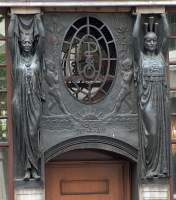 Cockspur Street Caryatids by Wenlock Rollins.
Cockspur Street Caryatids by Wenlock Rollins.
A figure at elevated height on a building is difficult to see properly from below, so Caryatids may lean their heads forward to look down at the pedestrian, as in the example below left. A slight variation is seen in the second picture, where four Caryatids lean their heads forward, their arms crossed above the temple. Next, the door of Temple Chambers, off the Strand in West London, with two warrior Atlantes supporting the window above. The figures here are departing considerably from the upright, and are arguably tending more towards bracket figures than substitutes for pillars. And on the far right, not Atlantes at all, showing how a bit more of a bend forwards takes us to more of an Atlas pose, with the weight resting on shoulders and back. Here at last we have a suggestion of weight-bearing, with the young male figures being not just bowed forwards, but placing their hands on their hips as if to brace themselves. This structure is the summit rotating globe on the Coliseum, the product of the fertile imagination of the theatre designer Frank Matcham.
Two groups of Caryatids leaning forward, Temple chambers Atlantes, and Matcham's Coliseum figures. 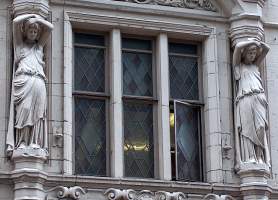
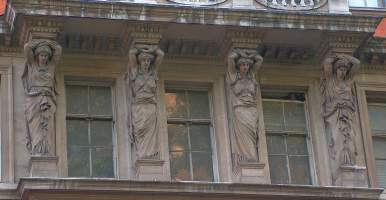
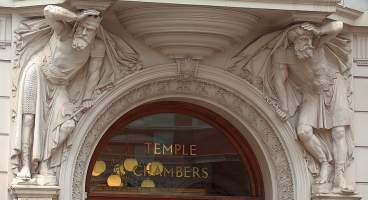
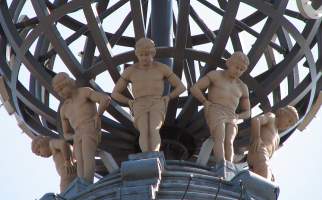
Below left, we have a proper Atlas for comparison, muscles tensed, kneeling on one foot which instead of being downwards pointing has been twisted to one side by the heaviness of the burden pressing down from above. The other figures here are Atlantes crouched in Atlas pose, and this class of figure is the principal exception to the ‘not bearing weight’ convention of other Atlantes and Caryatids. It is conventional for them to be unclothed, or nearly so, partly to make the link with heroic Classical figures, partly to more easily indicate their strength and power. The first example bears the weight on his upper back, and has one arm up to help support the mass, the other with hand resting on his knee to add support. The pair of terra cotta figures have an emphasis on the contracted muscles, much exaggerated, and the one on the left of this pair has arms twisted round to better support the corner of the structure above. The rather Deco figure on the right has an astonishing breadth to the chest, and suppots a pillar on his shoulders, his head leant forward, with a look of concentrated effort.
So much for the ‘Atlas crouch’. We move to the seated Caryatid now. Below left, a pair of semidraped figures, using male and female figures for contrast and variety, a clever composition by the architect Beresford Pite, apparently by the sculptors Tyrell and Slater. They are found on Mortimer Street, near Wigmore Street in London. These are certainly Caryatid and Atlantes rather than Atlas figures, and he seems to be balancing the pillar top behind his head rather than supporting it, though his muscular physique gives the suggestion of weight-bearing. By contrast, the female figure simply has her arms folded gracefully across her head. Next, a fully draped female who could be seen as either taking the place of a short pillar, or of a bracket. And a pair of nude girls most unequivocally replacing pillars – these being on the portico of the former West Ham New Technical Institute, by the Scottish sculptor Birnie Rhind.
Enough of full figure Caryatids and their brothers, the Atlantes. The other class of Caryatids are the half figures. If our full figures derive from the pure, ancient Classical, the half figures are more associated with the Renaissance and the Baroque. We see the concept in German drawings of the time of Durer, in chair and table legs from Italy and France, and then in the opulent and decadent French interiors through to the 18th Century. There is a Classical derivation, but not I think the architectural Caryatid, but the free standing Stele or Herm or Term, a male half figure dissolving into a square pillar below the shoulder or stomach, sometimes as a more or less overt symbol of fertility. We have examples of such figures from Victorian times – not Caryatids – but they clearly demonstrate an important point. That is, that the height and proportions of the lower part fits to the proportions of the figure it replaces. The figure below left, a statue called Harvest Time by Benjamin Lloyd, shows this well – the half figure becomes an elegant pillar where despite the upper rim, the curved line of the shaft so closely mirrors the line of the legs that we could imagine a full figure wearing tight drapes; the increased width of the base corresponds to how far the feet would stick out. The charming winged half-figure in the centre is cut off at the navel, and the height and taper of the pillar underneath feel proportionate to a tall figure with downward pointing feet – a greater or lesser width or height would be disproportionate or top-heavy. The right-hand figure cuts off below the shoulder and all the rest is pillar, but we still get the sense of a standing figure, with the swelling at the top front indicating the breast and the Acanthus leaf taking us down to the waist or groin, which by convention is emphasised in most half figures by some decoration or flower or even a little head. There is a stylistic link between the half figure Caryatid and the mermaid, where similarly, the fishy part is normally proportionate to the lower torso and legs it replaces (see the Mermaid page on this site for examples of keeping to and breaking this rule of thumb).

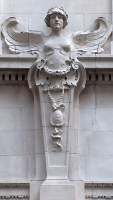
 Derivation of the half-figure from the Stele or Herm.
Derivation of the half-figure from the Stele or Herm.
Some examples of half figure Caryatids now. The exotic pair below left is from the entrance to the Royal Arcade in Albermarle Street, off Piccadilly in London. The full figures, swelling breasts and heart-shaped fans over the midriff all hearken back to ideals of fruitfulness, appropriate for a shopping arcade. The corner position mean the sides as well as the fronts of the figures are seen, so that the pillars below have carved decoration suggestive of the muscular forms of the lower limbs. The second Caryatid below, by Calder Marshall, has a full half figure, with drapes hanging down and pillar, tapering towards the foot as usual, with a proper capital above, which she reaches up to clasp. A very formal, classical treatment. Our third figure, again with drapes on the body above, is shown from the side to illustrate how closely the pillar can approach the proportions of leg and foot.
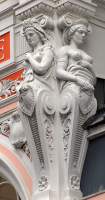

 Half-figure Caryatids showing different views of the figure and pillar.
Half-figure Caryatids showing different views of the figure and pillar.
Here are more examples, framing windows. The Caryatids below left make the half figure subordinate to the pillar; we have a symmetrical composition, stiffly upright, and the arms are lost to leave the pillar more pure in outline. The potential awkwardness of how to have a torso but no arms is dealt with by knotted fabric to indicate the shoulders, as if there could be arms clasped behind the back. The pair in the middle take the supremacy of the pillar yet further – only the head, breasts and stomach are left, and the pillar is square in cross section, with the girl’s torso no more than a surface variation on the flat front, with little compromise to indicate shoulders, and above, her headpiece being the decorative element of the capital. The group to the right reduces the figure to head and draped breast and no more, with even the top of the head lost to the architectural superstructure, and the flat sides containing swirls to indicate shoulders.
Caryatid half figures flanking windows; subordination of the figure to the pillar. 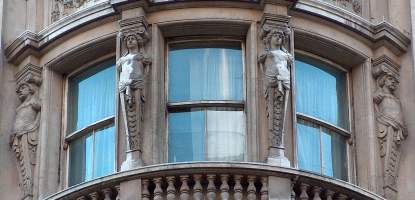
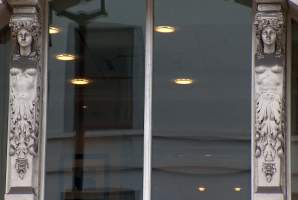
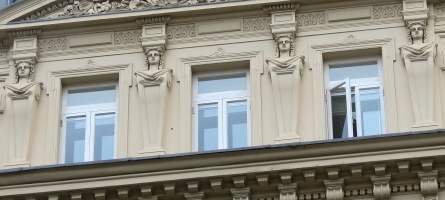
The variations are many. The height of the pillar can be varied considerably and still seem proportionate to the human figure, partly because a lengthening can betoken elegance, partly because the eye can take either the pillar height as being legs and feet or being just the legs with the feet indicated by the base, and partly because concealing drapes or shelf where the half figure joins the pillar can be used to stop the sweep of our glance up and down, so allow a bit more or less height than would look right were there to be a seamless join. Below left we have an oddity though – the rather long tapered pillar has at the base two little feet, which as soon as they catch the eye, suggests the pillar is a long skirt, which then makes it look too long, the width at the waist too wide, and the brawniness of the arms disproportionate to the dainty feet. Yet this is to the design of John Nash, on the end of the Regents Park terrace at the Baker Street entrance. The pair on the right, replacing the side pillars of a window, tend to the other direction, being about as short as can be done without making the proportions uneasy; there is no mass above, suggesting herm, but the raised arms crooked at the elbow suggest the support for a capital, as in conventional Caryatids. Here the outline is Baroque, with the curvaceousness of the figure becoming a curvy side pillar, with long ferny acanthus leaves stretching forward as if some decorative foot covering.
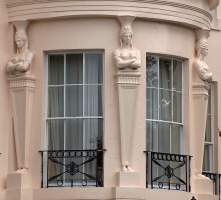
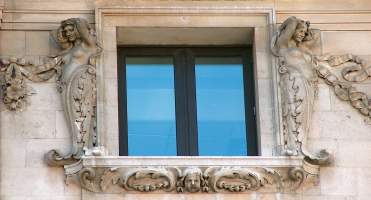 Classical Half figure with feet, design of John Nash; and Baroque examples, rather short.
Classical Half figure with feet, design of John Nash; and Baroque examples, rather short.
Here are some terra cotta examples of half figure Caryatids. First, rather decadent male and female Bacchanalian revellers, figures down to the waist and including the hips, then clusters of fruit and foliage and grotesque heads, with the pillar lightly outlined behind and below. Then two figures on a corner, of similar theme but with much more of a pillar from the front, and suggestive of the figure profile from the side. And by contrast, to the right, a symmetrical Orientalist terra cotta half figure, with turban and flowing beard, by one of the greatest designers in that material, W. J. Neatby.
A second division of the half figure is introduced below. Here we have half figures subordinate to their pillars, head supporting the capital, torsos covered with cartouches more suggestive of the architectural than the figural, no arms, and squared off, so that only the head is naturalistic. But the body of the pillar below is short, too short for a figure with normal length legs. In such cases, the half figure is used as a device of its own.
The most typical of such half figure Caryatids are used as brackets, as if sticking out of a wall, to support a balcony or other architectural feature which projects forwards further than a pillar. Male figures are much the more common, and here are examples. We see as with the full figures, examples of the bowed head and the raised arms across the head. These figures are essentially as if the figure is sticking out from the wall, and the treatment of where the body and wall meet is generally treated with either some skirt of leaves, or a dissolving into high relief ornamentation, to avoid the uneasy idea of a person stuck through a wall. The rightmost group, forming a corbel on the Institute of Chartered Accountants building, is actually a pair of tritons, but with the waist level as a semi-architectural feature as befits half-figures.
Half figures as brackets, and corbel. 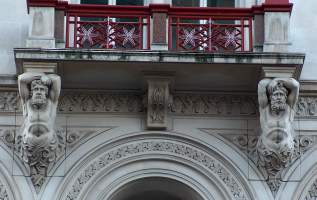
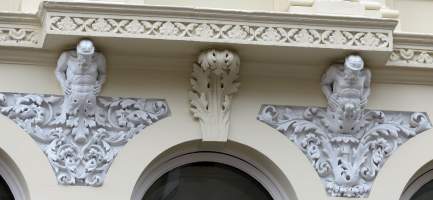
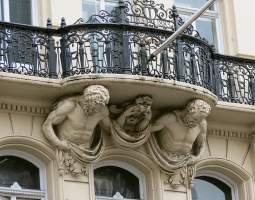
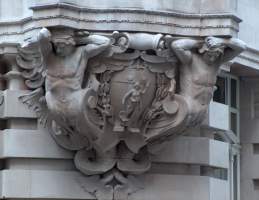
There are female examples of such half figures, as shown below left, very much of bracket form. And we end with a pair of examples of a compromise between bracket figure and half figure where the pillar is proportionate to the body – here there is such a proportionality, but the body bends too far forward and the lower part is too flat to be convincing as legs; except that if we take the figures as fauns, the mind’s eye can evoke the strange reverse-kneed goat’s legs that would allow for a posture such as that shown.
Architecture pages // Sculpture pages
Visits to this page from 13 Mar 2014: 30,001